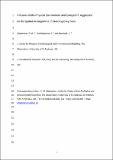Files in this item
Influence of the physical environment and conspecific aggression on the spatial arrangement of breeding grey seals
Item metadata
| dc.contributor.author | Harris, Catriona M | |
| dc.contributor.author | Matthiopoulos, Jason | |
| dc.contributor.author | Harwood, John | |
| dc.date.accessioned | 2010-10-22T12:30:25Z | |
| dc.date.available | 2010-10-22T12:30:25Z | |
| dc.date.issued | 2007-12 | |
| dc.identifier | 374465 | |
| dc.identifier | 99e7028f-fb80-4b47-9606-b4bba9d39460 | |
| dc.identifier | 000252061200002 | |
| dc.identifier | 36348951407 | |
| dc.identifier.citation | Harris , C M , Matthiopoulos , J & Harwood , J 2007 , ' Influence of the physical environment and conspecific aggression on the spatial arrangement of breeding grey seals ' , Ecological Informatics , vol. 2 , no. 4 , pp. 308-317 . https://doi.org/10.1016/j.ecoinf.2007.09.001 | en |
| dc.identifier.issn | 1574-9541 | |
| dc.identifier.other | ORCID: /0000-0001-9198-2414/work/60887685 | |
| dc.identifier.uri | https://hdl.handle.net/10023/1082 | |
| dc.description.abstract | Understanding the habitat requirements of a species for breeding is essential for its conservation, particularly if the availability of suitable habitat is a limiting factor for population growth. This is postulated to be the case for grey seals, one of the more abundant marine apex predators in northern European waters. In common with similar studies that have investigated the habitat preferences of breeding grey seals, we use abiotic (topographical, climatological) attributes but, unlike previous work, we also incorporate behavioural variables, particularly the occurrence of aggressive interactions between females and the presence of neighbouring seals. We used two Generalized Additive Models (GAM) in a sequential and iterative fashion. The first model links the occurrence of aggression at particular points in the colony to local topography derived from a Geographical Information System (GIS), presence of neighbouring seal pups and the day of the breeding season. The output of this GAM is used as one of the explanatory variables in a GAM of daily variation in the spatial distribution of births. Although proximity of a birth site to a water source and the presence of neighbouring seal pups both had significant influences on the distribution of newborn pups over time and space, at the scale of the study site it was found that simple rules could predict pup distribution more efficiently than a complex individual-based simulation model. (c) 2007 Elsevier B.V. All rights reserved. | |
| dc.format.extent | 10 | |
| dc.format.extent | 161148 | |
| dc.language.iso | eng | |
| dc.relation.ispartof | Ecological Informatics | en |
| dc.subject | Generalized additive models | en |
| dc.subject | GIS | en |
| dc.subject | Habitat suitability | en |
| dc.subject | Individual-based model | en |
| dc.subject | Pupping site selection | en |
| dc.subject | Spatial and temporal simulation modelling | en |
| dc.subject | Halichoerus-grypus | en |
| dc.subject | Site fidelity | en |
| dc.subject | North-Rona | en |
| dc.subject | Relating poulations | en |
| dc.subject | Landscape patterns | en |
| dc.subject | Models | en |
| dc.subject | Scotland | en |
| dc.subject | Distributions | en |
| dc.subject | Availability | en |
| dc.subject | QL Zoology | en |
| dc.subject | QH301 Biology | en |
| dc.subject | SDG 14 - Life Below Water | en |
| dc.subject.lcc | QL | en |
| dc.subject.lcc | QH301 | en |
| dc.title | Influence of the physical environment and conspecific aggression on the spatial arrangement of breeding grey seals | en |
| dc.type | Journal article | en |
| dc.contributor.institution | University of St Andrews. School of Biology | en |
| dc.contributor.institution | University of St Andrews. Sea Mammal Research Unit | en |
| dc.identifier.doi | https://doi.org/10.1016/j.ecoinf.2007.09.001 | |
| dc.description.status | Peer reviewed | en |
| dc.identifier.url | http://www.scopus.com/inward/record.url?scp=36348951407&partnerID=8YFLogxK | en |
This item appears in the following Collection(s)
Items in the St Andrews Research Repository are protected by copyright, with all rights reserved, unless otherwise indicated.

